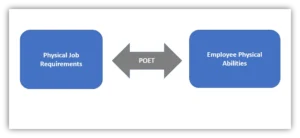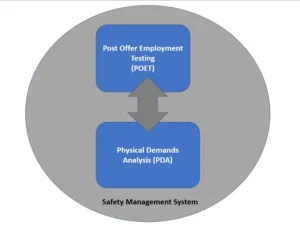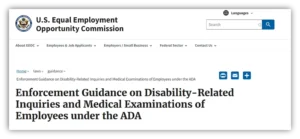EHS professionals traditionally deal with safety issues that employees encounter after they’ve been hired and have little involvement in processes to test employees before they start work – leaving the administration of that process to Human Resources (HR). Meanwhile, HR professionals managing post offer employment testing (POET) often aren’t involved in wider safety management practices. There’s a missed opportunity here to unify your safety management system around a robust POET program grounded in Physical Demands Analysis (PDA) that helps improve safety, develop business agility and increase your social sustainability maturity. But what constitutes an effective and legally compliant POET program?
In what follows, you’ll get the information you need to understand what POET is, how it works, why it depends on a good PDA process, and the benefits of implementing a program.
What is POET?
First, it’s important to understand that POET is not a general health or medical test. It’s a specifically tailored examination to test whether a candidate for a job is physically capable of performing the job they’ve applied to do. POET screenings can help reduce risks of musculoskeletal disorders (MSDs) that might come from strains, or “struck by” type injuries in which an employee drops something they didn’t have the strength to carry, thereby injuring either themselves or their coworkers.
Basically, POET helps objectively align the physical demands of a job with the physical abilities of employees, as shown in the image below.

The Relationship Between POET and Physical Demands Analysis (PDA)
Conducting POET effectively depends on first completing Physical Demands Analysis (PDA) for the job in question.
PDA is a process, usually detailed in an official document, which identifies and quantifies the physical demands required for employees to safely and effectively perform a job. The person completing a PDA should be a qualified health and safety professional, like a physical therapist, ergonomist, occupational therapist, or kinesiologist, one who’s trained in anatomy and physiology, how to take the necessary measurements, how to complete job task analysis, and in the relevant requirements of the Americans with Disabilities Act (ADA).
While PDAs vary in format and total level of detail, every PDA includes the following components:
- Job description: A written description of relevant features of the job, such as responsibilities required, shift length, and break length and frequency. It should also list the essential and non-essential duties/demands of the job. The essential features are those that are critical to completion of the job, while non-essential features could be assigned to others without altering the job’s purpose.
- Functional ability/objective measurements: These should include measurements of the amount of force, weight, distance or range of motion required for the job, as well as their frequency and duration.
These are the core pieces of a PDA, but the document should also include places to add notes and recommendations, images or media if needed, and information about environmental factors of the job (e.g., if PPE is required).
It should now be evident why doing POET right depends on doing PDA right. If we don’t first accurately assess the physical demands of the job, we can’t create a good post offer test, because we won’t know what physical aspects we should be testing. The diagram below shows the relationship between POET and PDA within a safety management system.

Note the dynamic relationship shown in the image above. If we identify issues with our PDA, or the nature of the job changes and we need to revise our PDA, then the POET test needs corresponding changes. Conversely, if your POET program isn’t working effectively, and you’re seeing evidence of employees performing jobs they’re not physically capable of doing, you should revisit your PDAs.
Understanding Americans with Disability Act (ADA) and Equal Employment Opportunity Commission (EEOC) Requirements
POET is a useful tool and can contribute to workplace safety when used in conjunction with a good PDA. But what specific considerations should an employer have to ensure that their tests treat employees fairly, and comply with applicable laws?
Some background is needed to understand the legal landscape, specifically, the jurisdictions and relationship between ADA and EEOC.
The Americans with Disabilities Act of 1990 prohibits discrimination against individuals with disabilities, including not only during employment but also in access to government services and public accommodations. The Equal Employment Opportunity Commission (EEOC), established by Title VII of the Civil Rights Act of 1964 to enforce laws against workplace discrimination, enforces the parts of the ADA applicable specifically to workplaces.
The next thing we should understand is that the rules are different, depending on whether we’re talking about pre-offer or post-offer testing. They’re different yet again once candidates begin employment, if in fact they do.
Prior to making an employment offer, an employer can ask applicants about their ability to perform job functions, along with the usual questions about their non-physical qualifications for the job. But they can’t, at this point, ask about disabilities or require employees to have medical examinations.
Things change once the employer has made an offer of employment to the candidate. Under the Americans with Disabilities Act of 1990 (the ADA), an employer can ask disability-related questions and require examinations of an applicant only after the job offer. They must inform the candidate that the employment offer is provisional, depending on demonstration of the physical ability to perform the job, in much the same way an offer is provisional pending a post-offer drug test.
In its “Enforcement Guidance on Disability-Related Inquiries and Medical Examinations of Employees Under the Americans with Disabilities Act (ADA),” EEOC states:
“Under the ADA, an employer’s ability to make disability-related inquiries or require medical examinations is analyzed in three stages: pre-offer, post-offer, and employment. At the first stage (prior to an offer of employment), the ADA prohibits all disability-related inquiries and medical examinations, even if they are related to the job. At the second stage (after an applicant is given a conditional job offer, but before s/he starts work), an employer may make disability-related inquiries and conduct medical examinations, regardless of whether they are related to the job, as long as it does so for all entering employees in the same job category. At the third stage (after employment begins), an employer may make disability-related inquiries and require medical examinations only if they are job-related and consistent with business necessity.”

Characteristics of a Good POET Test
A good POET program will help employees avoid creating safety risks from misalignment of physical demands with employee capabilities. But what constitutes a “good” POET test?
The structure of POET tests across employers and job sites shares some common features, such as weight and body fat, range of motion, limb strength, and the amount of weight they can safely lift for a specific distance, but the tests also vary based on the specifics of the job and its physical demands. Still, there are a few common key criteria to remember: objectivity, reliability and validity.
Objectivity
Perhaps the most useful way to define objectivity is as the opposite of subjectivity. Something that’s subjective is just a matter of opinion, based on perceptions of one or more people. But when there are facts to account for, and major consequences based on those facts, you want to ground decisions in good data. In the case of POET, you don’t want decisions made about a person’s capability to perform job tasks to be based only on human judgement, with all its potential for bias or just simple miscalculation. You want data – good, objective data collected by testing the candidate’s ability to meet the physical demands of the job as determined by the PDA.
Can candidates comfortably lift the weight determined to be critical to the job by the PDA, or can they pull or push with a specific amount of force over a specific distance? Measurements like these, especially when based on a well-established and documented PDA, help ensure that you’re making good decisions based on good data, and you’re treating all candidates fairly, rather than relying on vague assessments that candidates do or don’t look “strong” or capable of doing the job.
Reliability
Reliability is a feature of a test pertaining to whether it produces consistent and repeatable results over time. This means that if we were to administer the test to an employee one day, and then later re-administer the test to the same employee, we would receive largely similar results. If the same candidate tests well one day and tests poorly the next, the test is likely unreliable, and we’d lack assurance that it was providing meaningful information about the candidate’s physical ability to perform the job. Reliability also helps ensure that testing is the same for all candidates for a position, an important consideration for ADA and EEOC compliance and general equity.
Validity
Validity is a characteristic of a test pertaining to whether the test measures what it’s supposed to measure. Even if a test is reliable, i.e., it produces consistent results, it might lack validity, because it might consistently return similar values that don’t measure the right thing.
In practical terms, a valid POET test would accurately be able to predict a safe level of work for a specific employee.
Validity is a key aspect of regulatory compliance and is often the focus of legal cases. For example, in the 2016 case of OFCCP vs. Gordon Foods, the court found there was no base validity to the test used by the employer. The employer’s test had been based on general strength testing, which in the view of the court was not closely enough related to job function, and that the use of the test thereby discriminated against female candidates who would’ve been able to perform the required job tasks.
In another case, EEOC vs Hirschbach Motor Lines (2018), the court ruled against an employer who’d used a pre-employment back assessment to screen and reject applicants for truck driver positions, because the test requirements didn’t correlate to physical job demands. And in the case of EEOC vs Central Refrigerated Services, the court found that the employer’s post offer physical assessment test required more strength than the job itself required.
In all these cases, there were validity problems — disconnects between what the company’s POET system tested and actual physical demands of the job. This reinforces our earlier point that an effective and legally compliant POET program depends on a good PDA system. With PDA as the foundation of your POET program, you’re more likely to have valid tests that meet legal requirements because you will have systematically analyzed the actual physical demands of the job, and you’ll have the knowledge base to develop good post offer testing criteria.
Of course, an important aspect of maintaining valid testing is to periodically review PDAs to ensure they’re accurate and still reflect the performance of the job. Ideally, the employee designated to perform the job needs should review the PDA alongside a representative of the employer. The employer should also have a documented re-test policy, to define the circumstances in which re-tests are provided and ensure that any testing protocol issues identified trigger revision of the test.
Steps for Developing Legally Compliant and Effective Testing
Based on our discussion above, we can break down the process of developing an effective POET program into the following steps:
- PDA: This is the place to start, because it provides the information needed to devise a valid test. Direct measurement of distances and forces at this stage gives us a good baseline of knowledge about the job tasks.
- Test development: After analyzing the job and taking measurements, it’s time to develop a valid test. Clearly set down the criteria for “passing,” or acceptable performance. In an effective testing program, all pass/fail determinations for employees need to be accurate.
- Training: Make sure that the right people have the right information. The clinicians you’ll be using need to know what tests you’ve developed and how to administer them, and recruiters need to understand how to request tests and test results.
- Monitor and adjust: You’ll know your testing program is working when you see evidence that the job tasks employees are performing are well-aligned with their physical abilities. That is, you don’t observe evidence of employees straining or overexerting themselves or receive reports of such conditions from hazard reports or incident/injury reports. If you do find evidence of misalignments between employee physical abilities and job tasks demands, you’ll know you need to adjust somewhere, including potentially your tests, or at a foundational level, your PDA.
Note that in all the above areas, EHS professionals can coordinate with HR and medical professionals without endangering the confidentiality of medical information, because they pertain only to general program administration. This coordination will create an effectively broad approach to safety management focused on injury prevention.
Key Benefits of POET and PDA
If you take the time to develop a good POET program grounded in PDA, you’ll improve many aspects of safety and business performance.
Reduce workplace injuries and associated costs. By aligning employees with the physical demands of the job, you significantly reduce potential for injuries right at the source.
Reduce employee turnover. Employees who don’t experience or fear injuries at work are more likely to stay at their jobs. That also means you’ll reduce time and money spent training new employees because of turnover.
Reduce exposure to litigation. The legal cases discussed earlier are just a few of the most high-profile examples of litigation related to problems with POET testing. Remember, an employer can face lawsuits if they have a problematic POET program, or if they lack one. But having an effective POET program using valid tests based on PDAs provides the best chance to reduce legal liability and improve safety.
Improve productivity. Fewer injuries and associated downtime, reduced turnover, and lower anxiety levels lead to increased productivity.
Increase agility. The last few years have brought challenges for employers who had to significantly pivot work arrangements due to lockdowns and physical distancing protocols. Some companies able to do so shifted most of their workforce to remote work, while others used smaller staff on adjusted shift rotations. Those companies faced additional challenges managing Return to Work (RtW), as employees who had spent more time out of the workplace lost physical conditioning. PDAs give you the knowledge base you need to avoid physically overextending employees navigating their RtW journeys.
Pursue and achieve social sustainability. If you’ve explored Environmental, Social and Governance (ESG) as a management framework, you’ve probably seen references to social sustainability, which is part of the “S” in “ESG.” We can understand the term social sustainability as referring to building and supporting healthy and sustainable places, whether internal or external to our organization. The internal part of social sustainability overlaps with but goes beyond traditional safety management because it helps us account for the diversity of physical traits and abilities in our workforce, promote inclusion, and reduce psychosocial risks – sources of workplace anxiety related to the workplace itself or the nature of work. Developing a foundational PDA system and good POET programs can help you navigate the journey from EHS to ESG.
